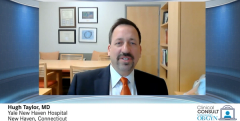
Approaching Treatment of Presumed Endometriosis
Dr Hugh Taylor discusses his treatment approach for patients with presumed endometriosis.
Episodes in this series

Hugh Taylor, MD: Most importantly, it’s the patient with presumed endometriosis, where we’ve made a clinical diagnosis of endometriosis. Somebody has that cyclic progressive pelvic pain, we think it’s endometriosis, we’ve ruled out other significant causes of pelvic pain, we don’t necessarily feel endometriosis on an examination, we don’t see it on an ultrasound, but the history is classic. I am very proactive in making a clinical diagnosis. The delay in treatment is so long right now. We’ve gone way too far to the side of missing diagnosis, harming patients because of this long delay, having them live years with inadequate or no treatment. I tend to be very aggressive at making a clinical diagnosis of presumed endometriosis and begin therapy. It’s gotten easier as our therapies have gotten easier.
Oral contraceptives were always easy and often we do that. We may not have made the diagnosis of endometriosis. We may have said it’s dysmenorrhea, light menses, and we’d start on our oral contraceptive. I’d make that clinical diagnosis of endometriosis. I’d let the patient know that is our working diagnosis, and I think it makes them feel much more heard, makes them feel like we are a true partner in treating this condition seriously. It allows us to go on to the next level of therapy if the pain is not relieved. I start with an oral contraceptive. If they have side effects or it doesn’t work, I'll move to a GnRH [gonadotropin-releasing hormone] antagonist. If they’re willing, I will often use the oral contraceptive in a continuous fashion. Most oral contraceptives are designed to be 3 weeks of active treatment and 1 week off to induce menses. If somebody has dysmenorrhea, why have menses at all? If menses are what are flowing in a retrograde fashion and feeding the endometriosis again, why have menses at all? When I can, I like continuous oral contraceptives to block menses entirely and eliminate that pain and potentially eliminate progression of disease or new lesions from forming.
I’m also not hesitant to go to a GnRH antagonist. When we just had the GnRH agonists as our next line of therapy or danazol, these are agents that had significant side effects. Most young women don’t want to take the risk of androgen therapy that may cause hair growth and acne, so danazol has not been a very popular treatment. When we had GnRH agonists as our treatment, where we had to give the patient an injection, knowing that it’ll have this flare effect where the disease would get worse for a week or 2 before it started to get better, knowing that this was irreversible at least for some time because of the slow-release depot formulation. Knowing that there were significant side effect, that it was this all- or- nothing response, we had to drop estrogen levels down to near zero—knowing all of these things, these were harder drugs to use and we wanted to be absolutely certain of our diagnosis and that would sometimes lead to doing laparoscopy just for diagnosis. I don’t do laparoscopy for diagnosis. I will make a clinical diagnosis.
We know that an oral contraceptive is effective in many women, but for those where the oral contraceptive is not effective we now have available the GnRH antagonists. These are oral, easy-to-use medication, act rapidly, can be reversed almost immediately, and where we can titrate the dose to get just the level of estrogen suppression to eliminate the pain often without the profound side effects. We can also give them with add-back therapy to eliminate vasomotor symptoms or other side effects if someone’s experiencing those, but given the ease of use of this medication, I think we can now make a clinical diagnosis of presumed endometriosis much more readily. We have more drugs in our armamentarium that make this easy to treat without the sort of profound commitment that we made when going on a GnRH agonist in the past. We wanted to make sure our diagnosis was 100% accurate. These days it’s much easier to treat with much milder patient-friendly medications with GnRH antagonists. It’s much easier to make that clinical diagnosis. We have to move the needle back on this to not wait 10 years from when someone has significant cyclic pelvic pain to the point where we relieve that pain with a definitive treatment. The field is moving toward clinical diagnosis and empiric early treatment, and I think that’s helping a lot of women.
Transcript Edited for Clarity
Newsletter
Get the latest clinical updates, case studies, and expert commentary in obstetric and gynecologic care. Sign up now to stay informed.













